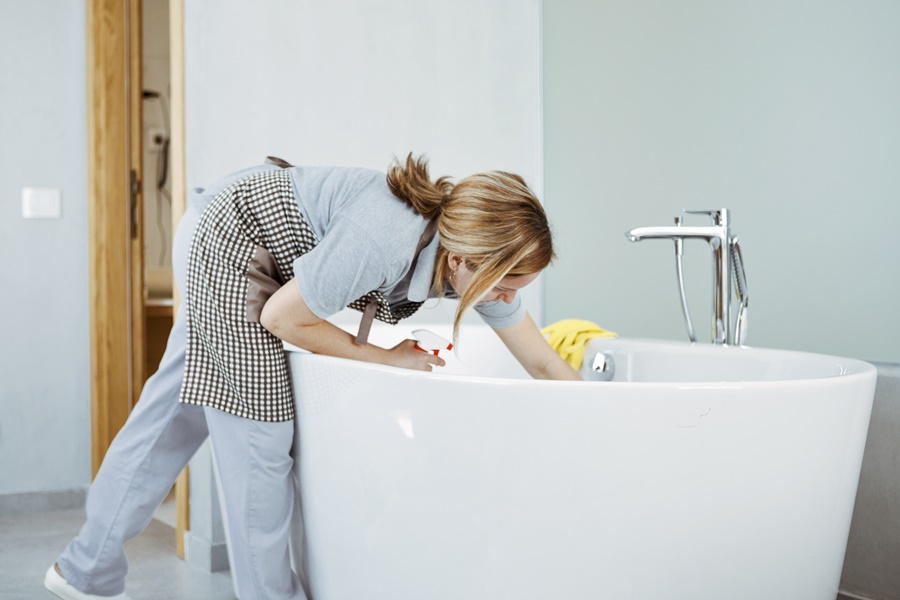Maintaining a spotless and hygienic bathtub not only enhances your bathroom’s aesthetics but also ensures a healthier space. Over time, bathtubs accumulate soap scum, hard water stains, mildew, grime, and even rust, which regular cleaning fails to eliminate. That’s where a deep clean becomes essential.
In this comprehensive guide, we break down exactly how to deep clean a bathtub using both natural solutions and heavy-duty methods to leave it sparkling like new.
What You’ll Need Before You Begin
Before you start, gather the following cleaning supplies and tools:
Baking soda
White vinegar
Dish soap
Hydrogen peroxide
Borax (optional)
A spray bottle
A non-abrasive sponge or scrub brush
Old toothbrush
Microfiber cloth
Rubber gloves
Bucket
Plastic wrap or paper towels
These supplies will help tackle every kind of stain, residue, and buildup without damaging your tub’s surface.
Step 1: Remove Items and Rinse the Tub
Start by removing all personal items, including shampoo bottles, soap bars, razors, and bath toys. Once cleared, rinse the tub thoroughly with hot water to loosen any grime or soap residue. This also helps to open up the pores in the tub material, making it more responsive to cleaning agents.
Step 2: Apply a Baking Soda and Dish Soap Paste
Create a cleaning paste using:
½ cup baking soda
2 tablespoons dish soap
Water to form a thick paste
Apply this mixture all over the tub’s surface, focusing on grimy spots. Baking soda works as a mild abrasive, while dish soap cuts through oils and grease. Let it sit for 15–20 minutes.
Step 3: Scrub the Surface Thoroughly
Using a non-abrasive sponge or brush, scrub the paste into the tub. Be sure to work in circular motions and apply extra pressure in corners and around the drain. For tight edges, grout lines, and fixtures, use an old toothbrush to dislodge dirt and mildew.
Step 4: Rinse with Warm Water
After scrubbing, rinse thoroughly with warm water. You’ll already notice a considerable improvement in the tub’s cleanliness. However, we’re just halfway through the deep-cleaning process. Now it’s time to target stubborn stains and hidden buildup.
Step 5: Tackle Stains with Vinegar and Baking Soda
For tough stains, especially from hard water or soap scum, follow this method:
1. Sprinkle baking soda generously over the stained areas.
2. Spray white vinegar over the baking soda. Let it fizz for 10–15 minutes.
3. After the fizzing stops, scrub again using your sponge or brush.
4. Rinse with warm water.
This natural chemical reaction breaks down mineral deposits and kills mold and mildew effectively.
Step 6: Use Hydrogen Peroxide for Deep Disinfection
If your tub is extra grimy or has mold, hydrogen peroxide adds a powerful disinfecting punch.
Mix 1 part hydrogen peroxide with 1 part water in a spray bottle.
Spray the solution over the tub, paying special attention to stained or mildewed areas.
Let it sit for 30 minutes.
Scrub and rinse thoroughly.
This method is safe for porcelain, enamel, and acrylic tubs while being tough on bacteria.
Step 7: Target Rust Stains and Mineral Buildup
For rust stains or stubborn mineral residue, use borax or a commercial rust remover:
Sprinkle borax directly onto the affected area.
Add lemon juice or vinegar over the borax.
Let sit for 15–20 minutes.
Scrub using a brush and rinse thoroughly.
Alternatively, rust remover products specifically formulated for bathroom surfaces can also be effective but always follow manufacturer instructions.
Step 8: Clean Fixtures, Faucets, and Drains
Your tub’s cleanliness isn't complete without shiny fixtures.
Soak paper towels in vinegar and wrap them around the faucets and handles.
Let them sit for 30 minutes to dissolve mineral deposits.
Remove the paper towels and scrub with a toothbrush.
Rinse and wipe with a microfiber cloth.
For clogged or slow drains, pour a mixture of:
½ cup baking soda
1 cup vinegar
Down the drain. Let it fizz for 10–15 minutes, then flush with boiling water to clear out debris and odors.
Step 9: Dry and Buff for a Gleaming Finish
Once everything is rinsed, use a dry microfiber cloth to wipe down all surfaces. This prevents water spots and gives your tub a polished, shiny finish.
For an extra glossy effect, a quick buff with car wax (safe for your tub type) can help repel future buildup.
Bonus Tips for Ongoing Bathtub Maintenance
Rinse the tub after every use to prevent soap scum buildup.
Wipe down the tub weekly with a mild cleaner or vinegar-water spray.
Use a tub mat to prevent scratches and trap debris.
Consider a bathroom dehumidifier to reduce mold and mildew formation.
Deep Cleaning Different Types of Bathtubs
Acrylic Tubs
Use only non-abrasive cleaners.
Avoid harsh chemicals like acetone or bleach.
Porcelain-Enameled Steel
Can withstand stronger cleaners, but avoid metal brushes to prevent chipping.
Fiberglass Tubs
Gentle cleaning agents recommended.
Avoid high-pressure scrubbing and acidic solutions.
Cast Iron Tubs
Durable, but enamel coating can chip use gentle abrasives only.
Knowing your tub’s material helps prevent long-term damage while maximizing cleaning effectiveness.
Eco-Friendly Natural Alternatives
Want to avoid chemical cleaners? These green cleaning solutions also work effectively:
White vinegar and citrus essential oil for odor and shine
Salt and lemon for rust and hard water stains
Castile soap mixed with baking soda for general scrubbing
Natural solutions are safe for kids, pets, and sensitive skin while being environmentally responsible.
When to Call in a Professional
If your bathtub has:
Deep cracks or chips
Stains that won't lift after multiple deep cleans
Persistent mildew or mold odor
Then it may be time to call in a professional bathtub refinisher or plumber to assess and restore your tub’s condition.
Conclusion
A clean bathtub is not just a matter of aesthetics it’s about hygiene, comfort, and care. By following the deep cleaning process outlined above, your tub will not only look brand new but also stay cleaner for longer. Regular upkeep, combined with periodic deep cleans, is the key to a beautiful, lasting bathtub.

